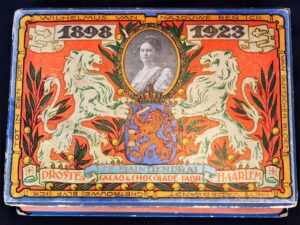BY STEPHANIE FOX

Images of Saint Valentine (left) and the pagan festival of Lupercalia in ancient Rome (right)
So! What’s love got to do with it? What does love have to do with Valentine’s Day? Today, Valentine’s Day is celebrated with gifts of chocolate and flowers and sentimental love poems. It is not, as some like to claim, an invention of Hallmark and greeting card companies, a sinister plot to make money.
The actual origins of this holiday go back more than 2,600 years and for much of that time, had little to do with romance.
Valentine’s Day began in ancient Rome, a fertility festival dedicated to Faunus, the god of agriculture and to the mythical founders of the city, Romulus and Remus. The holiday, called Lupercalia, is thought to have been celebrated as early as the sixth century BCE with blood sacrifices of male goats and a dog. After the sacrifices, two naked male pagan priests would smear themselves with the animals’ blood. And then, the feasting began.
After the feast, the priests would run through the streets, still naked, using strips of the goatskin to lash women, a gesture that was thought to increase a woman’s fertility. Most women welcomed this. Later, the priests and other men would each draw a woman’s name from a jar and the lucky woman would have a romantic (and sexual) encounter with the lottery winner. The woman would stay with the man for a year and often the two would marry after (maybe) falling in love.
Other deities also became connected with the holiday. Originally, Cupid was not the chubby little baby with a bow and arrow. He had his roots in the Greek god Eros, a tall, handsome deity who shot golden arrows, forcing people to fall in love. During the later Hellenistic period, the cute baby became the standard.
By the third century CE, the holiday changed. Some stories say that two (or more) Christian men named Valentine were executed by the anti-Christian Emperor Claudius II, but when Christianity became the state religion, the two Valentines became one saint, and their day was officially celebrated in mid-February. The pagan celebration was outlawed, replaced by St. Valentine’s Day.

The image of Cupid as a winged, chubby baby with bow and arrow evolved from the Greek god Eros.
A return to love and fertility
A thousand years later, the holiday began to take on some secular attributes. In parts of Europe, people believed that the mating season for birds began on Feb. 14, a return to the idea of fertility. The idea morphed from fertility to romantic love. In 1375, Geoffrey Chaucer wrote, “For this was sent on Seynt Valentyne’s day / Whan every foul cometh ther to choose his mate,” the first example of a written Valentine’s Day card. Soon, written valentines became popular.
The first romantic valentine is thought to have been written by the Duke of Orleans to his wife, while he was in an English prison after being defeated at the Battle of Agincourt. The 1415 letter can still be seen in the British Library’s manuscript collection.
In the 1660s a new custom emerged. Family and friends would get together for a Valentine’s Day party. Men would give gloves as a gift, as a proposal to a special woman. The man would have to wait until Easter Sunday to find if the answer was “I do” or “I don’t.” If the woman wore the gloves, she was saying, “Yes, you are my true love.”
Gloves became a tradition. Not winter gloves, but dress gloves, the kind that proper and well-dressed women continued to wear into the 20th century.
In old movies, you can see women dropping a glove, considered a symbol of love, and waiting for a favored male to pick it up and return it to her. A Valentine’s Day card from 1834 said, “If that from Glove you take the letter G, then Glove is Love and that I send to Thee.”
Valentine’s Day becomes international
The holiday has now spread around the world. In Japan, women give their male friends inexpensive chocolates, saving the fancier candies for their romantic partners. In Germany, traditional Valentine’s symbols are cute pig keepsakes and cartoons, considered good luck. In Ghana, a major producer of cocoa beans, Valentine’s Day is officially National Chocolate Day.

A COVID-era mass wedding of 220 couples at Bacolod City, Philippines, in February 2020
Finland and Estonia celebrate “Friends Day,” exchanging gifts and cards for a not-so-romantic holiday. In Norway, men write poems and create elaborate cards, called Gaekkebrev. Instead of a signature, they ink small dots, one for each letter of their name, and include a snowdrop flower with the card. If the recipient can guess who sent the card, he will give her a decorated egg at Easter. If she guesses wrong, she has to give him one instead.
In the Philippines, hundreds of couples gather in public places for mass marriages. Another tradition calls for couples to gather for a midnight kiss, hoping to beat a world kissing record. In 2020, COVID didn’t cancel the event, but changes were made with couples kissing and exchanging vows through blue surgical masks.
In Slovenia, where St. Valentine is considered the patron saint of spring, the old idea of the day as the beginning of the mating season of birds has been revived. It’s a tradition for people to walk barefoot through frozen fields to watch the birds propose marriage to each other and to connect to the coming spring. (Sounds like the kind of thing that would appeal to Minnesotans, especially those who head out in shorts when the mercury dips below zero.)
In Islamic Pakistan, the sale of Valentine’s Day-themed merchandise is banned, but the state has not been able to ban the exchange of flowers, a custom that has become increasingly popular.
And while for many Christians this is not a religious holiday, some Catholic churches in the United States will hold a blessing for couples as a dedication of their relationship.
From sweet to sophisticated to funny

A box of chocolates made by the Dutch chocolate company Droste to celebrate the silver jubilee of Queen Wilhelmina in 1923
In the 20th century, giving cards became more popular with the introduction of an elementary school tradition to exchange friendship-themed Valentine’s Day cards. In many schools, students create a decorative box for classmates to drop cards and sometimes candy (remember SweeTARTS?). Teachers also get cards and small gifts from their students.
For many in the United States, exchanging Valentine’s Day cards is the most popular of holiday traditions. Half of Americans (excluding school card exchanges) will send at least one Valentine’s Day card. More than 13% will mail cards to more than three people. An estimated 145 million Valentine’s Day cards are bought in the U.S. each year. Only Christmas card buying is bigger. That means 145 million cards will be delivered by the post office, costing post office patrons almost $8 million to spread the love.
Once, making a Valentine’s Day card was a do-it-yourself affair. The first commercial mass-market Valentine’s cards didn’t appear until 1849 when Esther Howland hired women artists to assemble cards in her home, selling them at her family’s stationery store. Soon, with new printing presses making the cards affordable, almost anyone could afford to send the romantic messages to their special friends. Before she sold her company in 1881, Howland was selling nearly $2 million worth of cards each year in today’s dollars. It took Hallmark until 1916 to start mass-producing Valentine’s Day cards.
Even best friends, parents, grandparents and kids expect to get a card from the people close to them. In the United States, even in these days of e-cards, sending a non-virtual card to a special person is a social requirement, even for millennials who now make up 20% of the greeting card (and Valentine’s Day card) market.
 For those looking for a very special card, artist Rosemary Buczek offers handmade Valentine cards, decorated with 23-karat gold and Swarovski crystals, starting at about $400, and made-to-order cards selling for more than $4,000.
For those looking for a very special card, artist Rosemary Buczek offers handmade Valentine cards, decorated with 23-karat gold and Swarovski crystals, starting at about $400, and made-to-order cards selling for more than $4,000.
So, Valentine’s Day really is for everyone, not just the romantically connected and the romantically inclined. While couples often observe the holiday by exchanging gifts and eating at fancy restaurants, everyone can celebrate – even our four-legged best friends.
While dogs and cats seldom get Valentine’s Day cards, a growing number of Americans buy treats, toys or other gifts for their pets at Valentine’s Day, spending nearly $2.14 billion in 2021 on their special friends, more than twice what they spent in 2020. Nearly 16% of Americans will spend an average of $31.24 for Valentine’s gifts for their dog, with 12.3% spending $27.42 for gifts for their kitties.
Don’t worry, though. If you forget to get Fido or Fluffy a gift, you’ll be forgiven, and they’ll still love you.






















